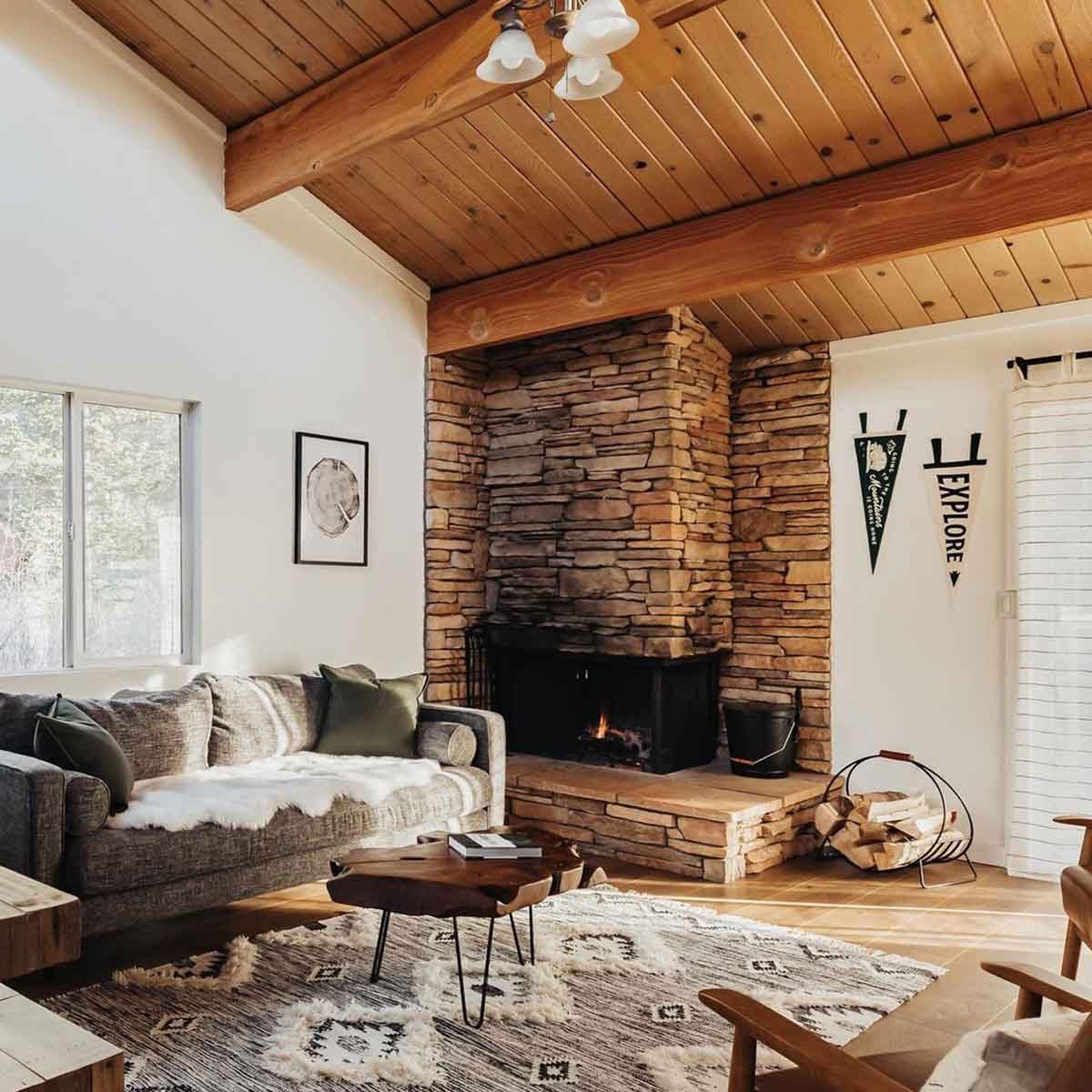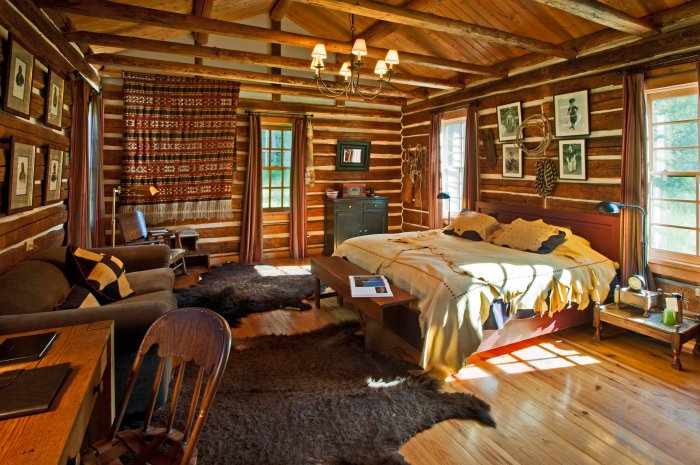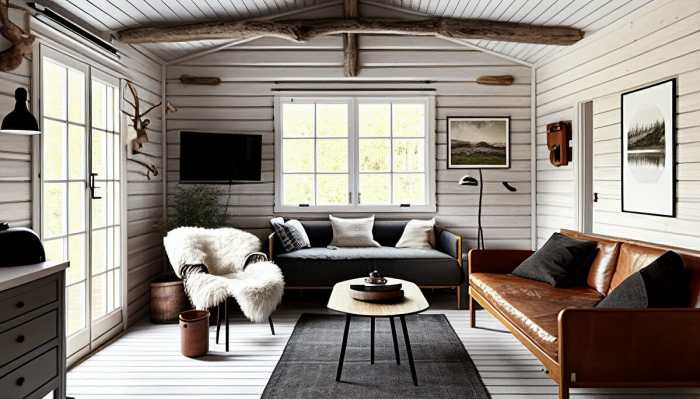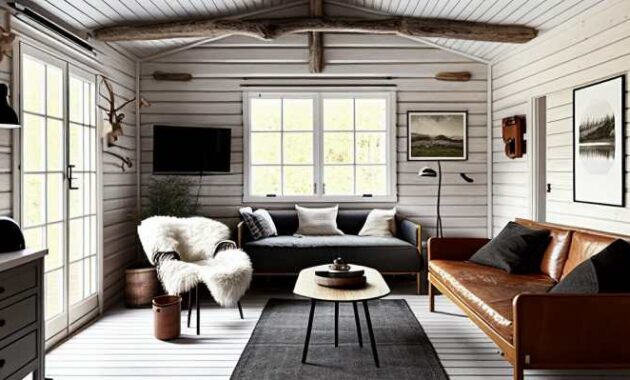Cabin house interior design offers a unique opportunity to create a space that feels both welcoming and grounded in nature. Whether you’re dreaming of a rustic retreat in the mountains or a cozy lakeside escape, the cabin aesthetic provides a canvas for blending warmth, functionality, and a touch of the outdoors.
This guide explores the essential elements of cabin house interior design, from defining the key characteristics of the style to incorporating modern touches that enhance the overall feel. We’ll delve into practical design considerations, explore different cabin house interior design styles, and highlight the importance of sustainability in creating a truly harmonious living space.
Creating a Cozy and Inviting Atmosphere

A cabin house interior should exude warmth and comfort, inviting you to relax and escape from the hustle and bustle of everyday life. To achieve this, it’s crucial to consider elements that create a sense of coziness and a welcoming ambiance.
Cabin house interior design often prioritizes a cozy and rustic aesthetic. This can be achieved through the use of natural materials, warm color palettes, and comfortable furniture. When working with limited space, however, maximizing functionality is key. For example, a 300 square feet house interior design can be incredibly efficient by incorporating clever storage solutions and multi-functional furniture.
This approach can be applied to cabin houses as well, allowing for a spacious and inviting feel even in a smaller space.
Incorporating Natural Light
Natural light is essential for creating a warm and inviting atmosphere in any space, especially in a cabin house. Large windows and skylights allow ample sunlight to flood the interior, brightening the space and making it feel more spacious.
- Placement of windows:Strategically placing windows to maximize natural light is crucial. Position them to capture the most sunlight throughout the day, especially during the morning and afternoon hours.
- Window treatments:Choose window treatments that allow maximum light penetration while still providing privacy. Sheer curtains or blinds that can be easily adjusted are ideal for maximizing natural light.
- Light-colored walls:Light-colored walls reflect natural light, making the space feel brighter and more spacious. Warm tones like cream, beige, or light gray can create a cozy and inviting ambiance.
Designing a Cozy Seating Area with a Fireplace
A fireplace is a quintessential element of a cabin house interior, providing warmth and a focal point for the living space. A well-designed seating area around the fireplace creates a cozy and inviting atmosphere for relaxation and socializing.
- Comfortable seating:Choose comfortable seating options like plush armchairs, oversized sofas, or cozy bean bags. Consider adding throw blankets and pillows for added comfort and warmth.
- Fireplace mantel:The fireplace mantel is a great opportunity to showcase personal touches and add to the cozy ambiance. Display framed photographs, artwork, candles, or other decorative items that reflect your personal style.
- Lighting:Dimmable overhead lighting and warm accent lighting around the seating area create a relaxing and inviting atmosphere. Consider using lamps, sconces, or string lights to add to the cozy ambiance.
Creating a Welcoming Entryway with a Rustic Touch
The entryway sets the tone for the entire cabin house, so it’s important to create a welcoming and inviting first impression. A rustic touch can enhance the cabin’s charm and create a warm and inviting atmosphere.
- Rustic furniture:A rustic bench or console table provides a place to store keys, hats, and other items while adding to the cabin’s charm. Choose pieces made from natural materials like wood or stone.
- Wall decor:Add a rustic touch to the walls with artwork, mirrors, or decorative items featuring natural elements like wood, antlers, or stones.
- Lighting:Warm lighting, such as a rustic chandelier or lanterns, creates a cozy and inviting ambiance in the entryway.
Functional and Practical Design: Cabin House Interior Design

A cabin house, while embracing a cozy and rustic aesthetic, should also be thoughtfully designed to be functional and practical. This means prioritizing space optimization, efficient layouts, and incorporating smart storage solutions to maximize usability and minimize clutter.
Organizing a Kitchen Space for Cooking and Dining
The kitchen is the heart of a cabin house, where meals are prepared and shared. It is essential to create a space that is both efficient for cooking and inviting for dining.
- Open Floor Plan:Consider an open floor plan that seamlessly integrates the kitchen with the dining area, creating a sense of spaciousness and flow. This arrangement allows for easy movement between the two areas, making it ideal for entertaining guests.
- Efficient Layout:The kitchen layout should be designed to promote efficiency. A well-planned layout ensures that the refrigerator, stove, sink, and work areas are positioned in a way that minimizes steps and maximizes workspace.
- Multifunctional Furniture:Incorporate multi-functional furniture pieces to maximize space. A kitchen island can serve as both a prep area and a dining table. Folding chairs or stools can be easily stored away when not in use.
- Storage Solutions:Utilize wall-mounted shelves, cabinets, and drawers to store kitchen essentials. A well-organized pantry can help to keep food items neatly stored and easily accessible.
Designing a Bathroom with a Rustic Yet Functional Aesthetic
The bathroom in a cabin house should reflect the rustic charm of the surrounding environment while maintaining a functional and comfortable space.
- Natural Materials:Incorporate natural materials like wood, stone, and reclaimed barn wood to create a rustic feel. Wood beams, stone accents, and distressed wood cabinets can add warmth and character.
- Minimalist Design:A minimalist approach to bathroom design can help to create a sense of calm and spaciousness. Keep the color palette neutral, and avoid overly ornate fixtures.
- Practical Fixtures:Choose practical and durable fixtures that complement the rustic aesthetic. For example, a farmhouse sink, a clawfoot tub, or a freestanding vanity can add a touch of charm while maintaining functionality.
- Storage Solutions:Utilize wall-mounted shelves, baskets, and freestanding storage units to keep toiletries and towels organized. A small linen closet can provide additional storage space.
Incorporating Storage Solutions in a Cabin House
Storage is crucial in a cabin house, especially when space is limited. Creative storage solutions can help to maximize functionality and minimize clutter.
- Built-in Storage:Maximize space by incorporating built-in storage solutions, such as under-stair storage, loft beds with storage drawers, and built-in bookshelves.
- Multifunctional Furniture:Choose furniture that serves multiple purposes, such as a coffee table with storage drawers or a bed frame with built-in storage.
- Wall-Mounted Shelves:Utilize wall space by installing open shelves for displaying decorative items or storing books and other essentials.
- Baskets and Bins:Baskets and bins can be used to organize and store items in a visually appealing way. Label them to make it easy to find what you need.
Cabin House Interior Design for Different Seasons

A cabin house is a place to escape the hustle and bustle of everyday life and reconnect with nature. However, the changing seasons can bring different challenges and opportunities to designing a comfortable and inviting cabin interior. To ensure your cabin is a cozy retreat throughout the year, consider designing for different seasons.
Designing a Cozy and Warm Interior for Winter
Winter in a cabin can be magical, with snow-covered landscapes and crackling fireplaces. To enhance the winter ambiance, incorporate warm colors like deep reds, browns, and creams. Natural materials like wood, wool, and leather add warmth and texture, while strategically placed throws and blankets invite snuggling.
A large fireplace is a focal point for gathering, and its warmth can create a cozy atmosphere. Large windows can showcase the winter wonderland outside, while strategically placed curtains help control the amount of light and maintain warmth.
Incorporating Outdoor Living Spaces into a Cabin House Design for Summer
Summer brings the opportunity to extend your living space outdoors. Design your cabin to seamlessly blend indoor and outdoor living. Consider a large deck or patio with comfortable seating, a fire pit for evenings, and a dining area for enjoying meals al fresco.
Cabin house interior design often embraces a rustic charm, with warm woods and cozy furnishings. However, similar principles of maximizing space and functionality can be applied to smaller dwellings, like a 1 bhk small house interior design. Clever storage solutions and multi-purpose furniture can create a welcoming and efficient space in a cabin or a compact apartment.
For privacy, consider incorporating natural elements like trees or shrubs, or adding a pergola or awning for shade. Outdoor lighting creates a magical ambiance in the evenings.
Tips for Transitioning a Cabin House Interior from One Season to Another, Cabin house interior design
To effortlessly transition your cabin from one season to another, embrace a few simple strategies.
- Seasonal Decor:Swap out heavy winter throws for lighter summer fabrics. Replace winter-themed artwork with vibrant summer scenes.
- Color Palette:Transition from warm winter colors to cool, refreshing hues like blues and greens for summer.
- Lighting:Adjust lighting to match the season. In winter, use warmer tones to create a cozy atmosphere. In summer, opt for brighter, cooler tones to mimic natural daylight.
- Outdoor Living:In summer, move your activities outdoors, utilizing your deck or patio. In winter, focus on creating a warm and inviting indoor space.
Final Summary
By embracing the natural elements, incorporating functional design, and adding personal touches, you can create a cabin house interior that reflects your unique style and provides a sanctuary for relaxation and rejuvenation. Whether you’re drawn to the rustic charm of reclaimed wood or the modern elegance of minimalist furniture, there’s a cabin house design waiting to be discovered.
Frequently Asked Questions
What are some common materials used in cabin house interiors?
Wood, stone, leather, and natural textiles like wool and linen are popular choices for creating a rustic and cozy atmosphere. Reclaimed wood is often used for furniture and accents, while stone can be incorporated into fireplaces, walls, and floors.
How can I incorporate natural light into a cabin house interior?
Maximize natural light by using large windows, skylights, and French doors. Consider using light-colored walls and furniture to reflect light throughout the space. Opt for sheer curtains or blinds to allow natural light to filter in.
What are some sustainable lighting options for a cabin house?
Choose energy-efficient LED bulbs and consider using solar-powered lighting fixtures for outdoor spaces. Incorporate natural light sources by strategically placing windows and skylights to illuminate the interior during the day.

